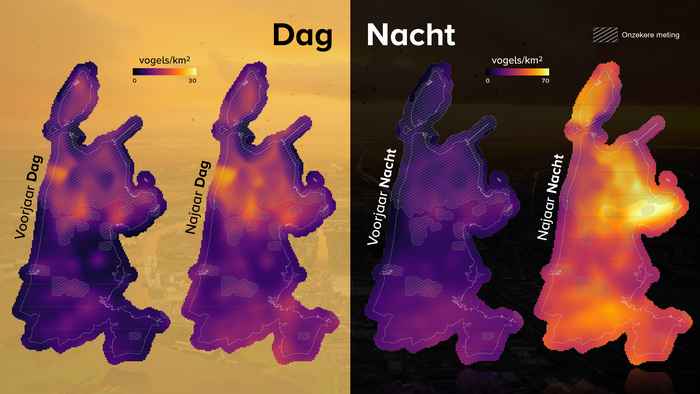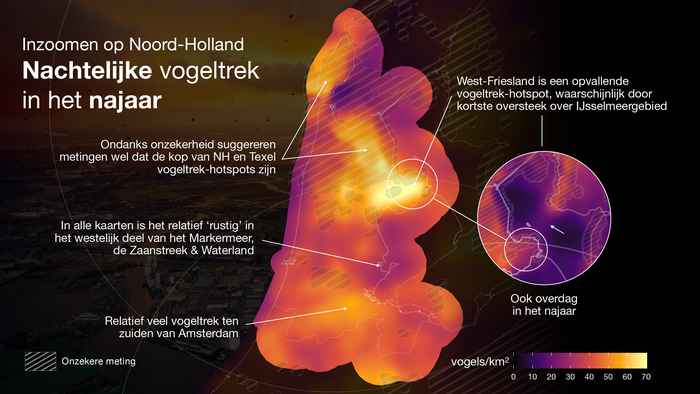Radars show bird migration and the risk of collision with wind turbines
3 July 2024
Using weather radars from the KNMI and a bird radar in ARTIS park, researchers from IBED mapped the largest movements of birds through the Netherlands: the mass migration in spring and autumn. "Twice a year, millions of birds fly over the Netherlands between their breeding areas in the Netherlands, Northern and Eastern Europe and their wintering areas in Africa, Southern Europe and the United Kingdom," says lead researcher Bart Hoekstra. 'Some birds migrate in large groups during the day. But most birds migrate at night, like a “carpet” of individual birds or small groups that spreads across the Netherlands.'

Bird migration maps North Holland
Using various radar data, the researchers analyzed bird migration through North Holland up to 1 kilometer high over a period of 6 years. This allowed them to properly map the different flight heights and the areas over which most birds migrate.
These unique bird migration maps show the average distribution of migratory birds during mass bird migration. The night migration in autumn is the most massive, with an average of 43 birds per square kilometer in North Holland. Day migration in spring is lowest with an average of 4 birds per square kilometer. “There are simply more birds in the autumn and most of them migrate at night because the atmosphere is quieter then,” Hoekstra explains.

Hotspots in Noord-Holland
There are also a number of hotspots within North Holland. West Friesland is one for bird migration in autumn nights. 'Migratory birds that fly over the IJsselmeer area probably prefer to take the shortest route.' The north of North Holland and Texel are also real bird migration hotspots and the bird density south of Amsterdam is relatively high. In the western part of the Markermeer, Waterland and parts of the Zaan region, bird densities are quite low.
Flight altitude
Massale vogeltrek vindt onder de 200m plaats. ‘Voor een belangrijk deel vliegen trekvogels op de hoogte van windturbines, dóór de rotorzone’, stelt Hoekstra. Dit geldt voor de trek in voor- én najaar en ‘s nachts, maar vooral voor de trek overdag. Wel is de hoogte waarop trekvogels vliegen sterk afhankelijk van het weer, vooral de wind. Bij wind mee vliegen ze hoger, en bij tegenwind juist lager.
Preventing collisions
The nocturnal migration in the autumn is the most massive, the researchers conclude. Moreover, the numbers of birds between areas differ the most at that time. “You can take this into account when looking for suitable locations for wind turbines,” Hoekstra explains. 'The bird migration maps can also help with precautionary measures after installation of wind turbines, for example to shut them down during intense night-time bird migration.'
Not the whole picture
The researchers warn that more than just bird migration plays a role in the choice of location for wind turbines. 'In addition to all kinds of social considerations, local research is also needed to take into account local movements of breeding and migratory birds. We have not investigated this. We only looked at the massive bird migration," says Hoekstra. This research provides the clients of the research - the Municipality of Amsterdam, the Municipality of Diemen and the Province of North Holland - with information about migratory birds in North Holland and the risk of collision with wind turbines.